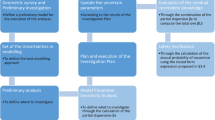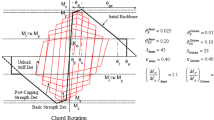Abstract
Given the importance that traditional force-based seismic design still currently exhibits, studies addressing issues related to the definition of the behaviour factor values are considered to be of most interest. A probabilistic methodology is proposed for the calibration of the q-factor relating its value with two fundamental parameters, the displacement ductility capacity measured at a relevant location of the structure and the failure probability P f . The general foundation of this procedure is based on the probabilistic quantification of the seismic action and, by applying a transformation procedure, of the structural seismic demand in terms of displacement ductility. By recalling well established structural reliability procedures and by making use of nonlinear analysis methods, both static and dynamic, a general probabilistic framework, which is able to relate the ductility capacity, the failure probability P f and the behaviour factor, is defined. In order to illustrate some of the potentialities of the methodology, an application example is presented, addressing the q-factor assessment for a set of regular and irregular reinforced concrete frame structures, enforcing a given P f and two different ductility levels.
Similar content being viewed by others
References
Arêde A, Pinto AV (1996) Reinforced concrete global section modelling: definition of skeleton curves. Special Publication No.I.96.36. Institute for Systems, Informatics and Safety, Joint Research Center, Ispra, Italy
ATC (1996) ATC 40—Seismic evaluation and retrofit of concrete buildings. Applied Technology Council, CA, USA
ATC (2005) FEMA 440—Improvement of nonlinear static seismic analysis procedures. Applied Technology Council, Washington DC, USA
Benjamin JR, Cornell CA (1970) Probability, statistics and decision for civil engineers. McGraw-Hill Inc., NY, USA
Bento R, Azevedo J (2000) Methodology for the probabilistic assessment of q-factors. A damage index approach. J Earthq Eng 4(1): 115–139. doi:10.1142/S1363246900000072
Booth ED, Kappos AJ, Park R (1998) A critical review of international practice on seismic design of reinforced concrete buildings. Struct Engineer 76(11): 213–220
Borzi B, Elnashai AS (2000) Refined force reduction factor for seismic design. Eng Struct 22(10): 1244–1260. doi:10.1016/S0141-0296(99)00075-9
CEB (1996) RC frames under earthquake loading. Bulletin no.231, Comité Euro-International du Béton.
CEB (1997) Seismic design of RC structures for controlled inelastic response. Bulletin no.236, Comité Euro-International du Béton.
CEN (2004), EN 1998-1 eurocode 8: design of structures for earthquake resistance, part 1: general rules, seismic actions and rules for buildings. European Committee for Standardization.
Colangelo F, Giannini R, Pinto PE (1995) Seismic reliability analysis of R/C structures with stochastic properties. Struct Saf 18(2/3): 151–168
Cornell CA, Jalayer F, Hamburger R, Foutch D (2000) Probabilistic basis for the 2000 SAC/FEMA steel moment frame guidelines. J Eng Mech 128(4): 526–533
Costa AG (1989) Seismic analysis of irregular structures. PhD Thesis, Faculty of Engineering of the University of Porto, Porto, Portugal (in Portuguese).
Costa AC (1993) Seismic actions and the behaviour of structures. PhD Thesis, Faculty of Engineering of the University of Porto, Porto, Portugal (in Portuguese).
Chryssanthopoulos MK, Dymiotis C, Kappos AJ (2000) Probabilistic evaluation of behaviour factors in EC8-designed R/C frames. Eng Struct 22(8): 1028–1041. doi:10.1016/S0141-0296(99)00026-7
Duarte RT (1991) The use of analytical methods in structural design for earthquake resistance. In: Donea J, Jones PM (eds) Experimental and numerical methods in earthquake engineering. Kluwer Academic Publisher, Ispra, Italy
Elghazouli AY, Castro JM, Izzuddin BA (2008) Seismic performance of composite moment-resisting frames. Eng Struct 30(7): 1802–1819. doi:10.1016/j.engstruct.2007.12.004
Elnashai AS, Mwafy AM (2002) Overstrength and force reduction factors of multi-storey RC buildings. Struct Des Tall Build 11(5): 329–351. doi:10.1002/tal.204
FEMA (2000) FEMA 356—Prestandard and commentary for the seismic rehabilitation of buildings. American Society of Civil Engineers. Federal Emergency Management Agency, Washington DC, USA
Ferry Borges J, Castanheta M (1985) Structural safety, Publication 101, 2nd edn. Laboratório Nacional de Engenharia Civil, Lisbon, Portugal
Kappos AJ (1999) Evaluation of behaviour factors on the basis of ductility and overstrength studies. Eng Struct 21(9): 823–835. doi:10.1016/S0141-0296(98)00050-9
Maheri MR, Akbari R (2003) Seismic behaviour factor, R, for steel X-braced and knee braced RC buildings. Eng Struct 25(12): 1505–1513. doi:10.1016/S0141-0296(03)00117-2
Miranda E, Bertero VV (1994) Evaluation of strength reduction factors. Earthq Spectra 10(2): 357–379. doi:10.1193/1.1585778
Miranda E, Ruiz-Garcia J (2002) Influence of stiffness degradation on strength demands of structures built on soft soil sites. Eng Struct 24(10): 1271–1281. doi:10.1016/S0141-0296(02)00052-4
Mwafy AM, Elnashai AS (2002) Calibration of force reduction factors for RC buildings. J Earthq Eng 6(2): 239–273. doi:10.1142/S1363246902000723
Lee LH, Han SW, Oh YH (1999) Determination of ductility factor considering different hysteretic models. Earthq Eng Struct Dynam 28(9): 957–977. doi:10.1002/(SICI)1096-9845(199909)28:9<957::AID-EQE849>3.0.CO;2-K
Romão X, Guedes J, Costa A, Delgado R (2008) Analytical evaluation of structural component limit state probabilities. Bull Earthq Eng 6(2): 309–333. doi:10.1007/s10518-007-9056-z
Pinto D (1994) Behaviour coefficients in reinforced concrete frames. M.Sc. Thesis, Faculty of Engineering of the University of Porto, Porto, Portugal (in Portuguese).
Pinto PE, Giannini R, Franchin P (2004) Seismic reliability analysis of structures. IUSS Press, Istituto Universitario di Studi Superiori di Pavia, Pavia, Italy
Priestley MJN, Calvi GM, Kowalsky MJ (2007) Displacement based seismic design of structures. IUSS Press, Istituto Universitario di Studi Superiori di Pavia, Pavia, Italy
RSA (1983) Safety and action regulation for structures of buildings and bridges. Diário da República no. 238/83, Casa da Moeda (in Portuguese).
Rodrigues H (2005) Development and calibration of numerical models for the seismic analysis of buildings. M.Sc. Thesis, Faculty of Engineering of the University of Porto, Porto, Portugal (in Portuguese).
Salvitti LM, Elnashai AS (1996) Evaluation of behaviour factors for RC buildings by nonlinear dynamic analysis. Proceedings of the Eleventh World Conference on Earthquake Engineering, Acapulco, Mexico.
Thomos GC, Trezos CG (2005) Behaviour factor of RC structures: a probabilistic approach. Proceedings of the fifth international Conference on earthquake resistant engineering structures, Skiathos, Greece.
Thomos GC, Trezos CG (2006) Examination of the probabilistic response of reinforced concrete structures under static non-linear analysis. Eng Struct 28(1): 120–133. doi:10.1016/j.engstruct.2005.08.003
Vamvatsikos D, Cornell CA (2002) Incremental dynamic analysis. Earthq Eng Struct Dynam 31(3): 491–514
Varum H (1997) Numerical model for the seismic analysis of reinforced concrete plane frames. M.Sc. Thesis, Faculty of Engineering of the University of Porto, Porto, Portugal (in Portuguese).
Zeris CA, Tassios TP, Lu Y, Zhang GF (1992) Influence of irregularity on the q factor of RC frames. Proceedings of the tenth world conference on earthquake engineering, Madrid, Spain.
Author information
Authors and Affiliations
Corresponding author
Rights and permissions
About this article
Cite this article
Costa, A., Romão, X. & Oliveira, C.S. A methodology for the probabilistic assessment of behaviour factors. Bull Earthquake Eng 8, 47–64 (2010). https://doi.org/10.1007/s10518-009-9126-5
Received:
Accepted:
Published:
Issue Date:
DOI: https://doi.org/10.1007/s10518-009-9126-5




